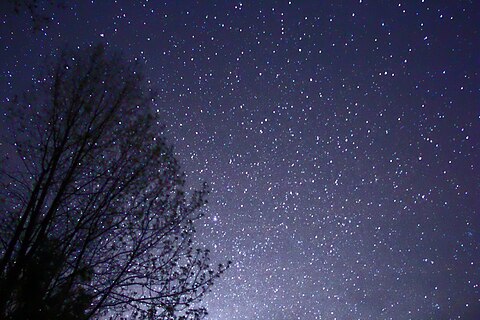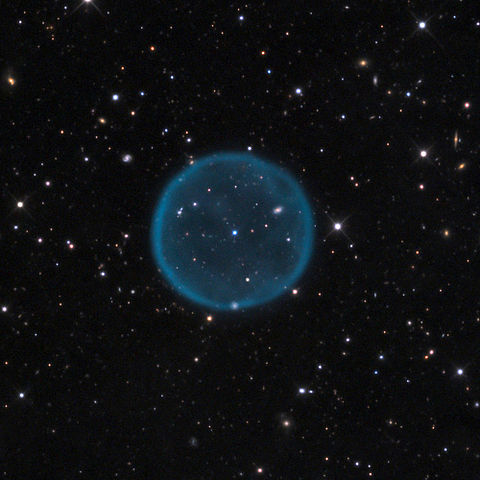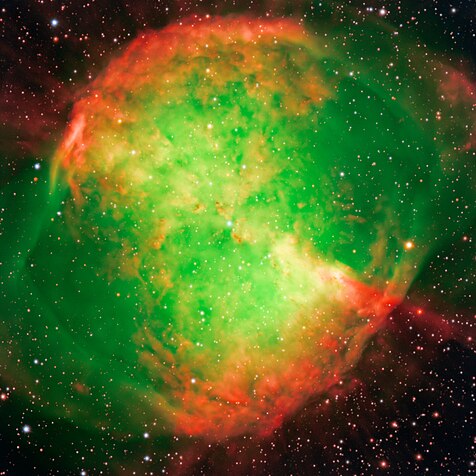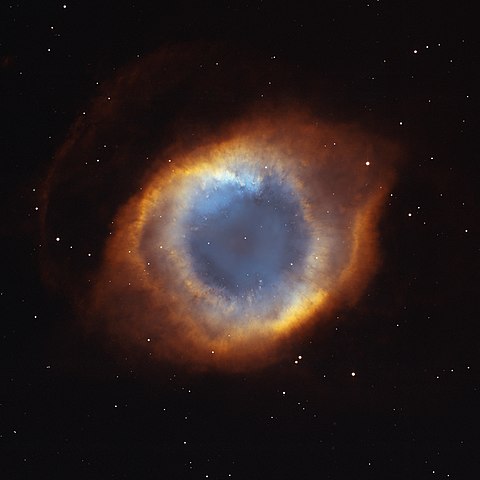But Hubble isn't the only great telescope out there. In fact, while it is still a very valuable instrument contributing much to current science, its capabilities have in many ways been eclipsed by other instruments. After all, the Hubble was conceived and designed when an Apple II computer, running at 1MHz with an 8 bit processor and about 128KB of RAM was a serious work computer. So, while we recognize and accept the greatness of Hubble, let's have a look at some other telescopes that have been eclipsed by its popularity.
The Chandra X-Ray Observatory

Despite coming from the same overall program as Hubble, the Chandra has gotten far less notoriety. Its images are no less beautiful, and are arguably more scientifically valuable since much of what Hubble does could be reproduced with other instruments. The same can't be said of Chandra.
The Spitzer Space Telescope

Infrared observations are especially important compared to visual light because IR wavelengths penetrate gas and dust better than visual wavelengths. On top of that, the effects of red-shift--light being shifted to lower frequencies by the expansion of the universe--means that to observe the visual light emissions of far away objects in space we need to look for infrared light here. It's been red-shifted out of the visual light spectrum entirely. Observations of the early universe rely on IR telescopes. This is why the new large space telescope, the Keck, often hailed as "Hubble's replacement", is being designed to work in IR wavelengths.
Aside from its scientific value, Spitzer also produces images of great beauty and wonder. Like Chandra, it has lived in Hubble's shadow for over ten years now.
The Great Observatories were originally rounded out by the Compton Gamma Ray Observatory. Its stabilization systems broke down after years of operation, and it was brought back down into the atmosphere for destructive re-entry. The remaining Great Observatories are still working today to produce valuable new science.
Fermi Gamma Ray Telescope

Fermi was originally called GLAST after its main instrument, the Gamma ray Large Area Space Telescope. Once again, this telescope is designed to see things that Hubble can't see. Rather than looking as small, specific parts of the sky it scans the entire sky every three hours. It is used to image particles that are travelling just under the speed of light, the most energetic particles in the universe. This allows us to study physics in ways that we can't reproduce in laboratories on Earth. You think the Large Hadron Collider is powerful? The physics powerhouses that Fermi studies make LHC look like a pop-gun!
Large Binocular Telescope

Today, the relatively unknown Large Binocular Telescope sports a pair of mirrors, each 331 inches in diameter! That means each mirror has over 2.7 times the light collecting area of Palomar's Hale telescope. Together, it's about five and a half times the light collecting area. But, as they say in the commercials, that's not all.
The Large Binocular Telescope uses adaptive optics (AO). This is a means of flexing the optical surfaces of the telescope to get the best possible image. The adaptation happens in real time, allowing the telescope to eliminate much of the problems from observing from the ground, rather than in space. In essence, if we'd had working adaptive optics back when Hubble was being designed, we would have already had ground-based telescopes that can see as well or better than Hubble! If we'd gone ahead with launching a telescope into space (still a good idea), then we would have had to build a telescope even more amazing than Hubble to justify the extra cost and effort (Hubble cost as much or more than a huge ground-based observatory project.)
But, reality is that we pulled together all the parts to build adaptive optics into ground based observatories after the commitment had already been made to Hubble. So now we have many ground based observatories that can out-perform Hubble, the Large Binocular Telescope among them.
The South African Large Telescope

The Magellan Telescopes

Image by Krzysztof Ulaczyk
The Keck Observatory

The Keck Observatory was the great project that brought together so many of the advancements from the time between the start of work on Hubble and Hubble reaching its scientific potential. It used segmented mirrors to produce a collecting area far greater than the Palomar and Bolshoi telescopes. It added adaptive optics, as well as a second advancement to the optical train, active optics.
Active optics are similar to adaptive optics, in that they make adjustment to the optics of the telescope in real time to make a better image. Active optics, however, primarily correct environmental problems from being on the ground, rather than correcting problems with the image caused by the atmosphere (which is the purpose of adaptive optics.) Active optics correct for the pull of gravity on the mirrors changing as the telescope moves to follow objects across the sky. It corrects for changes in temperature, mechanical stresses on the mirrors, and so on.
Active optics keeps the mirrors within the telescope's main reflector as perfect a reflector for the telescope as possible. Then adaptive optics kick in later to clean up the effects of the atmosphere. The result is that the Keck can produce more detailed images than Hubble.
On top of that, Kick added a second telescope that can combine with the first to work like one really huge telescope. This not only increases the light collecting area, but the apparent aperture size of the telescope. That allows for resolution of finer detail (whereas increased collecting area allows the detection of fainter objects.)
Gran Telescopo Canarias

Image by Christoffer H. Støle
Atacama Large Millimeter/submillimeter Array

Image by ESO/B. Tafreshi (twanight.org)
While the far longer wavelengths it observes in would normally mean that it has to give up high detail and positional accuracy to do so, ALMA spreads its reflectors, radio telescopes that all work together as a single instrument, across 16km to get the aperture necessary to get even higher detail than the most detailed visible light and IR telescopes.
ALMA is the result of many millimeter/submillimeter wave projects coming together into one larger, more capable system. Many countries worked together and committed resources to create ALMA. As I write, ALMA is still in development. It is already producing amazing images that no other telescope in existence can make. If you're looking for a telescope that may steal Hubble's crown as the most talked about telescope, ALMA is a good bet. You can get in before the rush, and start spreading the word.
Future Telescopes
There are several more great telescopes on the near horizon, including the Giant Magellan Telescope and NASA's James Webb Space Telescope. Not to mention at least two other giant telescopes in the works.
Hubble will remain useful for as long as it continues to function. Originally, its retirement was planned to come about as a return to Earth via the Space Shuttle. That's not going to happen now, the present plan is to send up a robot spacecraft to guide it to a destructive re-entry. No matter how its life ends, its place in the history books is secure. What's important is to remember that it's not the only game in town.











